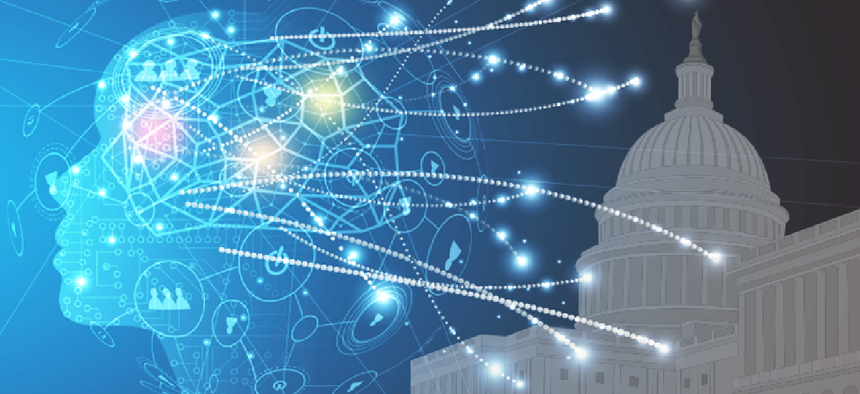AI's true benefit for government

Productivity projections assume that federal workers and executives are widely empowered to make the most of the new AI tools at their disposal, but at present, this is not the case.

There is hardly a federal mission or business left unaltered by artificial intelligence in some fashion. Agencies today employ AI to adjudicate cases, improve military readiness, perform data analysis, enhance logistics and maintenance activities, streamline administrative functions, conduct regulatory and law enforcement and much more.
Federal leaders would be the first to admit that these applications are just the beginning. Market researcher IDC projects that federal government's spending on AI will grow from $250m in 2018 to $1B in 2023. Bloomberg Government is even more bullish, with federal AI spending reaching $1.1B in 2019 following 43% year-over-year growth.
What can the federal government expect to see from its investment? To find out, we employed an economic model to measure AI's impact on federal workforce productivity. The ROI was impressive. Based on current investment trends, our analysis projects a $364 billion gain in productivity for the federal workforce in 2028. Increasing the rate of spend modestly, growing from $3.8 billion [31% Compound Annual Growth Rate] in 2028 to $7.4 billion (40% CAGR), would yield a staggering $532 billion in added value that same year.
To put productivity gains of $532 billion (our high-end estimate) in perspective, this is equivalent to roughly 2.4% of our national GDP last year, and it would be 1.7 times greater than the current federal civilian payroll.
A chief reason why the productivity payoff would be so high is that federal workers perform a lot of complex work that is particularly ripe for augmentation from AI tools (versus more straightforward automation). Our cross-industry model projects that roughly half (49%) of the time that federal workers spend on current tasks could eventually be augmented with AI. Of the 15 industries that we reviewed, the federal government trails only education (63%), health and social work (52%) and financial operations (51%) in this regard.
But it is important to note that AI won't affect all federal jobs equally. Federal employees with "technical equipment maintenance" functions, for example, may have about 36% of their time affected by AI-driven augmentation. Those with "process and analysis" jobs may have about 44% of their time augmented; and workers in "science and engineering" jobs may have about 54% of their time augmented.
To better understand what AI-enabled productivity can look like in government, consider a couple of current examples.
At the Social Security Administration, claims adjudicators use AI-based tools to help expedite disability benefits claims. For example, they are using machine learning to identify medical documentation typically required to support a specific disability claim. This can reduce or eliminate time-consuming and frustrating back and forth communication with the claimant, allowing the adjudicator to spend more time reviewing the actual claim.
The U.S. Patent and Trademark Office is enhancing its on-premise search tools with AI. The upgrade uses machine learning and design thinking to better understand what examiners are looking for in order to improve search performance. With faster access to more relevant information, examiners can work more effectively in reviewing applications.
Of course, there are caveats to consider with these productivity estimates. One is that productivity gains from AI often reveal themselves in non-conventional ways.
As MIT's Erik Brynjolfsson observed in an influential 1994 paper The Productivity Paradox of Information Technology: "Intangibles such as better responsiveness to customers and increased coordination with suppliers do not always increase the amount or even intrinsic quality of output. But they do help make sure it arrives at the right time, at the right place, with the right attributes for each customer." And it is reasonable to assume that what applied to past IT breakthroughs may well apply to future AI breakthroughs.
Secondly, our productivity projections assume that federal workers and executives are widely empowered to make the most of the new AI tools at their disposal. At present, this is not the case.
Another Accenture survey found that 85% of federal executives believe that "collaboration between humans and machines will be critical to innovation in the future." Yet, the same survey found that only 18% were preparing their workforces to interact with collaborative, interactive, and explainable AI-based systems.
These findings, among others, indicate that more must be done to make the most of the government's surging investment in AI. So, what will it take for federal employees to make the most of AI?
For one thing, considerable amounts of education, training and technical investment. Our model suggests that, under the current baseline investment scenario, the federal government could see up to $66.5 billion in AI productivity gains vanish in 2028 if employees are not given needed training to complement machines, allowing both to work together in new ways.
For example, for federal staffs to trust and rely on their AI tools, agencies will need to invest in making them "explainable," so it is clear how and why those tools come up with the results they do.
In addition, AI tools often must be continuously monitored, tuned and refreshed to ensure their results are valid, relevant to the task and free of bias. This is a field that is advancing rapidly, and agencies must stay on top of those advances to achieve desired productivity improvements, maintain an edge over foreign adversaries and meet ever-rising citizen expectations.
There is clearly tremendous potential for AI to make government far more productive, effective, and efficient. But agencies will need to ensure that they fully leverage their considerable AI investments.





